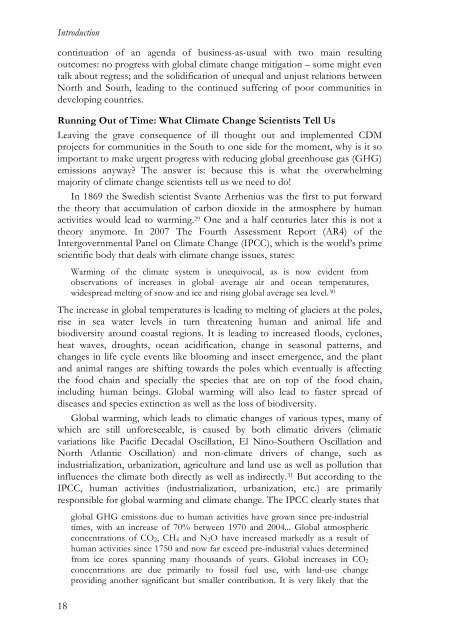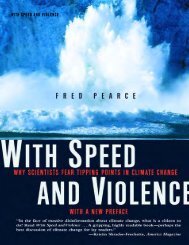- Page 1 and 2: Upsetting the Offset The Political
- Page 3 and 4: Today, at one and the same time, sc
- Page 6 and 7: Upsetting the Offset: The Political
- Page 8 and 9: Contents Contributors Acknowledgmen
- Page 10: ALTERNATIVES 24 Repaying Africa for
- Page 13 and 14: Contributors co-founder of the open
- Page 15 and 16: Contributors workshops on creativit
- Page 17 and 18: Contributors magazine, Down To Eart
- Page 20: Acknowledgments First and foremost
- Page 23 and 24: Foreword Offsets Under Kyoto: A Dir
- Page 25 and 26: Forewords While Northern government
- Page 27 and 28: Forewords Carbon trading is one of
- Page 30 and 31: 1 Upsetting the Offset: An Introduc
- Page 32 and 33: Upsetting the Offset What are Carbo
- Page 34 and 35: Upsetting the Offset Joint Implemen
- Page 36 and 37: Upsetting the Offset you might crea
- Page 40 and 41: Upsetting the Offset observed incre
- Page 42 and 43: Upsetting the Offset Given the domi
- Page 44 and 45: Upsetting the Offset 8 Lohmann, L.
- Page 46 and 47: 2 Neoliberalism and the Calculable
- Page 48 and 49: Upsetting the Offset ‘equivalent
- Page 50 and 51: Upsetting the Offset commensuration
- Page 52 and 53: Upsetting the Offset Mechanism, yet
- Page 54 and 55: Upsetting the Offset major energy-m
- Page 56 and 57: Upsetting the Offset The troubled t
- Page 58: Upsetting the Offset 28 Lohmann, L.
- Page 62 and 63: 3 Double Jeopardy: Pursuing the Pat
- Page 64 and 65: Upsetting the Offset chapter by arg
- Page 66 and 67: Upsetting the Offset ostensibly seq
- Page 68 and 69: Upsetting the Offset Without foliag
- Page 70 and 71: Upsetting the Offset Although the K
- Page 72 and 73: Upsetting the Offset poisoned strea
- Page 74 and 75: Upsetting the Offset Conclusions Ce
- Page 76 and 77: Upsetting the Offset Georgia, 2006,
- Page 78 and 79: 4 How Sustainable are Small-Scale B
- Page 80 and 81: Upsetting the Offset The staple cro
- Page 82 and 83: Upsetting the Offset piles up on ev
- Page 84 and 85: Upsetting the Offset The main sourc
- Page 86 and 87: Upsetting the Offset field was on a
- Page 88 and 89:
Upsetting the Offset The success of
- Page 90 and 91:
Upsetting the Offset able to resist
- Page 92 and 93:
Upsetting the Offset The potential
- Page 94 and 95:
Upsetting the Offset ‘choices’
- Page 96 and 97:
Upsetting the Offset Yet, these cri
- Page 98 and 99:
Upsetting the Offset ‘internation
- Page 100 and 101:
Plants linked to a CDM project La M
- Page 102 and 103:
Upsetting the Offset supposedly aim
- Page 104 and 105:
Upsetting the Offset The CDM is jus
- Page 106 and 107:
33 http://www.transalta.com/transal
- Page 108 and 109:
Upsetting the Offset would do simpl
- Page 110 and 111:
Upsetting the Offset the form of lo
- Page 112 and 113:
Upsetting the Offset of proven rese
- Page 114 and 115:
Upsetting the Offset The case of th
- Page 116 and 117:
Upsetting the Offset reality on the
- Page 118 and 119:
Upsetting the Offset 15 World Bank
- Page 120 and 121:
Upsetting the Offset A NFA official
- Page 122 and 123:
Upsetting the Offset displaced from
- Page 124 and 125:
Upsetting the Offset it? By, for ex
- Page 126 and 127:
Upsetting the Offset into debt to p
- Page 128 and 129:
Upsetting the Offset something bett
- Page 130 and 131:
Upsetting the Offset International
- Page 132 and 133:
Upsetting the Offset 25 Ramos, I. a
- Page 134 and 135:
Upsetting the Offset company sells
- Page 136 and 137:
Upsetting the Offset The workers ha
- Page 138 and 139:
Upsetting the Offset afro-descendan
- Page 140 and 141:
10 Clean Conscience Mechanism: A Ca
- Page 142 and 143:
Upsetting the Offset environment is
- Page 144 and 145:
Upsetting the Offset sulphur compou
- Page 146 and 147:
Upsetting the Offset These arrangem
- Page 148 and 149:
Upsetting the Offset checks and bal
- Page 150 and 151:
11 India’s ‘Clean Development
- Page 152 and 153:
Upsetting the Offset the CDM projec
- Page 154 and 155:
Upsetting the Offset else, how do t
- Page 156 and 157:
Upsetting the Offset With India’s
- Page 158 and 159:
Upsetting the Offset as a rule, ign
- Page 160 and 161:
Upsetting the Offset Development Me
- Page 162 and 163:
Upsetting the Offset constitutes of
- Page 164 and 165:
Upsetting the Offset slightest by t
- Page 166 and 167:
Upsetting the Offset places, as in
- Page 168 and 169:
Upsetting the Offset 4 The CDM proj
- Page 170 and 171:
Upsetting the Offset Sustainable De
- Page 172 and 173:
Upsetting the Offset ! The economic
- Page 174 and 175:
14 The MSPL Wind Power CDM Project
- Page 176 and 177:
Upsetting the Offset ! Capacity-bui
- Page 178 and 179:
Upsetting the Offset been met. Nor
- Page 180 and 181:
15 The Deogad Hydroelectric CDM Pro
- Page 182 and 183:
Upsetting the Offset 3000, and the
- Page 184 and 185:
16 Offsetting Lives and Livelihoods
- Page 186 and 187:
Upsetting the Offset GHG driven Cli
- Page 188 and 189:
Upsetting the Offset in these calcu
- Page 190 and 191:
Upsetting the Offset by the Asian p
- Page 192:
Upsetting the Offset arises with th
- Page 196 and 197:
17 Regulation as Corruption in the
- Page 198 and 199:
Upsetting the Offset comprising big
- Page 200 and 201:
Upsetting the Offset Corruption as
- Page 202 and 203:
Upsetting the Offset credits and th
- Page 204 and 205:
Upsetting the Offset crop yields, c
- Page 206 and 207:
Upsetting the Offset for the volunt
- Page 208 and 209:
Upsetting the Offset It should be s
- Page 210 and 211:
36 Financial Times, 16 February 200
- Page 212 and 213:
Upsetting the Offset the legal or i
- Page 214 and 215:
Upsetting the Offset in developing
- Page 216 and 217:
Upsetting the Offset don’t get yo
- Page 218 and 219:
Upsetting the Offset free-market en
- Page 220 and 221:
Upsetting the Offset This dominant
- Page 222 and 223:
Upsetting the Offset Notes 1 Bernst
- Page 224 and 225:
19 Rent Seeking and Corporate Lobby
- Page 226 and 227:
Upsetting the Offset delegations. A
- Page 228 and 229:
Upsetting the Offset Conference of
- Page 230 and 231:
Upsetting the Offset (‘grandfathe
- Page 232 and 233:
Upsetting the Offset for the seller
- Page 234 and 235:
Upsetting the Offset 23 Annex I Par
- Page 236 and 237:
Upsetting the Offset of conservatio
- Page 238 and 239:
Upsetting the Offset the markets in
- Page 240 and 241:
Upsetting the Offset receipt and th
- Page 242 and 243:
Upsetting the Offset boasts that
- Page 244 and 245:
Upsetting the Offset necessary with
- Page 246 and 247:
Upsetting the Offset agricultural c
- Page 248 and 249:
Upsetting the Offset 19 ‘Money gr
- Page 250 and 251:
Upsetting the Offset 63 ‘Context:
- Page 252 and 253:
Upsetting the Offset extreme neolib
- Page 254 and 255:
Upsetting the Offset engendering a
- Page 256 and 257:
Upsetting the Offset ! Environmenta
- Page 258 and 259:
Upsetting the Offset If emissions t
- Page 260 and 261:
Upsetting the Offset land expropria
- Page 262 and 263:
Upsetting the Offset CDMWatch/ Sink
- Page 264 and 265:
Upsetting the Offset 59 ‘Man is t
- Page 266 and 267:
Upsetting the Offset leapt upon by
- Page 268 and 269:
Upsetting the Offset obligations. T
- Page 270 and 271:
Upsetting the Offset markets is abo
- Page 272 and 273:
Upsetting the Offset the aura of an
- Page 274 and 275:
Upsetting the Offset 4 United Natio
- Page 276 and 277:
23 Green Capitalism, and the Cultur
- Page 278 and 279:
Upsetting the Offset Conservation b
- Page 280 and 281:
Upsetting the Offset initiatives el
- Page 282 and 283:
Upsetting the Offset that they allo
- Page 284 and 285:
Upsetting the Offset thereby legiti
- Page 286 and 287:
Upsetting the Offset Cultured Lands
- Page 288 and 289:
Upsetting the Offset to a modern wo
- Page 290 and 291:
Upsetting the Offset Notes " This c
- Page 292 and 293:
Upsetting the Offset 45 WBCSD (2009
- Page 294:
IV ALTERNATIVES Part IV of the book
- Page 297 and 298:
Alternatives campaigners like Wanga
- Page 299 and 300:
Alternatives payment of ecological
- Page 301 and 302:
Alternatives Ghana was $40 and educ
- Page 303 and 304:
Alternatives AU Commission, represe
- Page 305 and 306:
Alternatives ! We emphasize that ec
- Page 307 and 308:
Alternatives There are important de
- Page 309 and 310:
Alternatives because we’re runnin
- Page 311 and 312:
Alternatives 9 http://www.globalpol
- Page 313 and 314:
25 Rethinking the Legal Regime for
- Page 315 and 316:
Alternatives North-South division m
- Page 317 and 318:
Alternatives First, it is increasin
- Page 319 and 320:
Alternatives on commitments with a
- Page 321 and 322:
Alternatives recognizes that human
- Page 323 and 324:
Alternatives to addressing the glob
- Page 325 and 326:
Alternatives that some countries ha
- Page 327 and 328:
Alternatives 11 See, e.g., Report o
- Page 329 and 330:
Alternatives materials best suited
- Page 331 and 332:
Alternatives by industrial farming
- Page 333 and 334:
Alternatives longer any other optio
- Page 335 and 336:
Alternatives begin to inform the ma
- Page 337 and 338:
Alternatives " This article has bee
- Page 339 and 340:
Alternatives This definition, of co
- Page 341 and 342:
Alternatives Profitability and self
- Page 343 and 344:
28 Cycles of Sustainability: From A
- Page 345 and 346:
Alternatives campervan, or a modern
- Page 347 and 348:
Alternatives anything to challenge
- Page 349 and 350:
Alternatives practice by reclaiming
- Page 351 and 352:
Alternatives the world appears on a
- Page 353 and 354:
Alternatives environment is an ‘e
- Page 355 and 356:
29 Towards the Sustainable School:
- Page 357 and 358:
Alternatives decision making and pr
- Page 359 and 360:
Alternatives the current crop of ch
- Page 361 and 362:
Alternatives 340 operative enterpri
- Page 363 and 364:
Alternatives sustainability agenda
- Page 365 and 366:
Alternatives 36 Wintour, P. (2008)
- Page 367 and 368:
Alternatives treatment, organic foo
- Page 369 and 370:
Alternatives Bioneers Bioneers is a
- Page 371 and 372:
Alternatives This could provide ele
- Page 373 and 374:
Alternatives No Till Farming Reduce
- Page 375 and 376:
Alternatives It reminds us of a tru
- Page 378 and 379:
Afterword On the Road to Copenhagen
- Page 380 and 381:
Upsetting the Offset that baseline
- Page 382 and 383:
Upsetting the Offset climate action
- Page 384:
Upsetting the Offset and armed mili
















